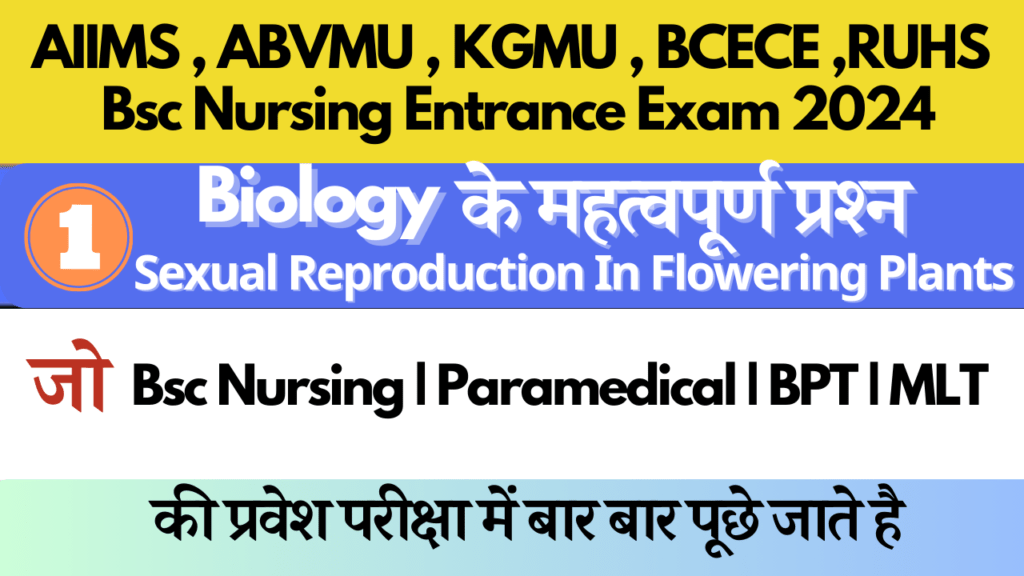Bsc Nursing Most Important Questions CNET , KGMU , ABVMU , AIIMS , BCECE

Sexual Reproduction In Flowering Plants MCQs
- An embryo may sometimes develop from any cell
of sac other than egg. It is termed as
a. apospory
b. apogamy
c. parthenogenesis
d. parthenocarpy - Embryo sac is to ovule as an anther. is to:
a. Stamen
b. (b) filament
c. (c) pollen grain
d. (d) androecium - The outermost and innermost wal layers of
microsporangium in an anther are respectively
a. endothecium and tapetum endodermis
b. epidermis and
c. epidermis and middle layer
d. epidermis and tapetum. - During microsporogenesis, meiosis occurs in
a. endothecium
b. microspore mother cells
c. microspore tetrads
d. pollen grains - From among the sets of terms given below,
identify those that are associated with the
gynoecium.
a. Stigma, ovule, embryo sac, placenta
b. Thalamus, pistil, style, ovule
c. Ovule, ovary, embryo sac, tapetum
d. Ovule, stamen, ovary, embryo sac - Science of cultivation, breeding, marketing and
arrangement of flowers is called
a. arboriculture
b. floriculture
c. horticulture
d. anthology - Nonessential floral organs in a flower are
a. sepals and petals
b. anther and ovary
c. stigma and filament
d. petals only. - The stamens represent
a. microsporangia
b. male gametophyte
c. male gametes
d. microsporophylls. - Anther is generally :
a. monosporangiate
b. bisporangiate
c. letrasporangiate
d. trisporangiate. - The anther wall consists of four wall layers
where
a. tapetum lies just inner to endothecium
b. middle layers lie between endothecium and
tapetum
c. endothecium lies inner to middle layers
d. tapetum lies next to epidermis. - The innermost layer of anther i_{s} tapetum
whose function is
a. dehiscence
b. mechanical
c. nutrition
d. protection. - Callase enzyme which dissolves callose of
pollen tetrads to separate four pollens is
provided by:
a. pollens
b. tapetum
c. middle layers
d. endothecium. - In angiosperms various stages of reductional
division can best be studied in
a. young anthers
b. mature anthers
c. young ovules
d. endosperm cells. - Study of pollen grains is called
a. micrology
b. anthology
c. palynology
d. pomology - Several pollen grains form a unit designated as
pollinium in Family
a. Asteraceae
b. Cucurbitaceae
c. Asclepiadaceae Pollen
d. Brassicaceae - Triple fusion in Capsella bursa pastoris is
fusion of male gamete with
a. egg
b. synergid
c. secondary nucleus
d. antipodal. - Double fertilisation was first discovered in
1898 by in Fritillaria and Lilium.
a. Nawaschin
b. Strasburger
c. Amici
d. Fockesperm contains
24 chromosomes, the number of chromosomes in
each cell of the root will be
a. 8
b. 4
c. 16
d. 24 - The cells of endosperm have 24 chromosomes.
What will be the number of chromosomes in the
gametes ?
a. 8
b. 16
c. 23
d. 32 - The true embryo develops as a result to fusion of
a. two polar nuclei of embryo sac
b. egg cell and male gamete
c. synergid and male gamete
d. male gamete and antipodals. - The true embryo develops as a result to fusion of
a. two polar nuclei of embryo sac
b. egg cell and male gamete
c. synergid and male gamete
d. male gamete and antipodals
Here are 20 Most Important MCQs On Sexual Reproduction in Flowering Plants for Bsc Nursing for Students Preparing For NEET | ABVMU | CNET | RUHS |





[…] Part 2 Target Gurukul […]
[…] Sexual Reproduction In Flowering Plants […]